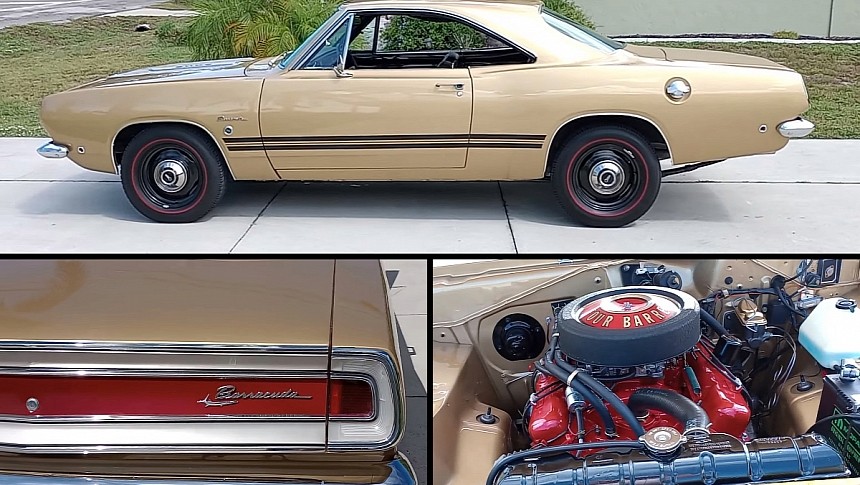When it comes to the Plymouth Barracuda, everyone seems to be drooling over the third-generation model. And I can get that because the early 1970s 'Cudas are gorgeous, powerful, and highly sought-after. But this 1968 Barracuda in Ember Gold proves that second-gen cars are also stunning when appropriately restored.
Finished in Ember Gold, a relatively rare color on 1968 Barracudas, this Mopar looks better than new. And it's not just the finely applied paint. The black stripes running along the sides and the chrome trim are also perfect. Moreover, the interior is just as gorgeous and highly original.
The good news continues under the hood with a squeaky clean, numbers-matching V8. This Barracuda left the factory with a four-barrel, 340-cubic-inch (5.6-liter) mill, which was brand-new for the 1968 model. Slotted between the 318-cubic-inch (5.2-liter) small-block and the 383-cubic-inch (6.3-liter) big-block, it generated 275 horsepower and 340 pound-feet (461 Nm) of torque when new.
Sure, it's not as powerful as the four-barrel 383 or the super-rare 440-cubic-inch (7.2-liter) version offered in 1969, but it was potent enough to push the coupe down the quarter-mile in less than 15 seconds, according to period tests. And that's quicker than many big-block-powered muscle cars from the golden era.
This Barracuda also rocks a Formula S package. Introduced in 1965, the bundle usually included a revised suspension that improved cornering, larger wheels, special emblems, and a tachometer. In simpler terms, the Formula S was a performance-oriented package. The presence of the bundle also makes this coupe notably scarcer than the average Barracuda.
Of the 45,412 units sold in 1968, only about 5,000 cars were equipped with the bundle. Records show that 1,270 of them were ordered with the 383 V8, which leaves us with 3,730 units fitted with the smaller 340 lump. There's no official info on how many were notchback coupes, but we can apply the same 11% ratio to this body style. Since Plymouth sold 19,997 examples, it's safe to say that around 2,200 notchbacks were specified with the Formula S package.
Suppose we also factor in the Ember Gold paint, the 340 V8 engine, and the automatic transmission. In that case, we can probably narrow it down to less than 200 examples. Not that it makes much of a difference in my book. This Barracuda is arguably the finest 1968 example I've seen in a very long time. It's what all barn finds hope to become when they're saved.
The second-generation Barracuda was introduced for the 1967 model year with a significant redesign. While it retained the A-body platform, it got a more stylish and aggressive shell and a wide range of V8 powerplant. Unlike the Road Runner and the GTX, the Barracuda did not get the 426 HEMI, but Plymouth offered a limited-edition version with the 440 RB. The company sold almost 140,000 units through 1969.
But that's enough history for today. Check out the videos below for a full walkaround of this stunning Mopar.
The good news continues under the hood with a squeaky clean, numbers-matching V8. This Barracuda left the factory with a four-barrel, 340-cubic-inch (5.6-liter) mill, which was brand-new for the 1968 model. Slotted between the 318-cubic-inch (5.2-liter) small-block and the 383-cubic-inch (6.3-liter) big-block, it generated 275 horsepower and 340 pound-feet (461 Nm) of torque when new.
Sure, it's not as powerful as the four-barrel 383 or the super-rare 440-cubic-inch (7.2-liter) version offered in 1969, but it was potent enough to push the coupe down the quarter-mile in less than 15 seconds, according to period tests. And that's quicker than many big-block-powered muscle cars from the golden era.
This Barracuda also rocks a Formula S package. Introduced in 1965, the bundle usually included a revised suspension that improved cornering, larger wheels, special emblems, and a tachometer. In simpler terms, the Formula S was a performance-oriented package. The presence of the bundle also makes this coupe notably scarcer than the average Barracuda.
Of the 45,412 units sold in 1968, only about 5,000 cars were equipped with the bundle. Records show that 1,270 of them were ordered with the 383 V8, which leaves us with 3,730 units fitted with the smaller 340 lump. There's no official info on how many were notchback coupes, but we can apply the same 11% ratio to this body style. Since Plymouth sold 19,997 examples, it's safe to say that around 2,200 notchbacks were specified with the Formula S package.
Suppose we also factor in the Ember Gold paint, the 340 V8 engine, and the automatic transmission. In that case, we can probably narrow it down to less than 200 examples. Not that it makes much of a difference in my book. This Barracuda is arguably the finest 1968 example I've seen in a very long time. It's what all barn finds hope to become when they're saved.
The second-generation Barracuda was introduced for the 1967 model year with a significant redesign. While it retained the A-body platform, it got a more stylish and aggressive shell and a wide range of V8 powerplant. Unlike the Road Runner and the GTX, the Barracuda did not get the 426 HEMI, but Plymouth offered a limited-edition version with the 440 RB. The company sold almost 140,000 units through 1969.
But that's enough history for today. Check out the videos below for a full walkaround of this stunning Mopar.













